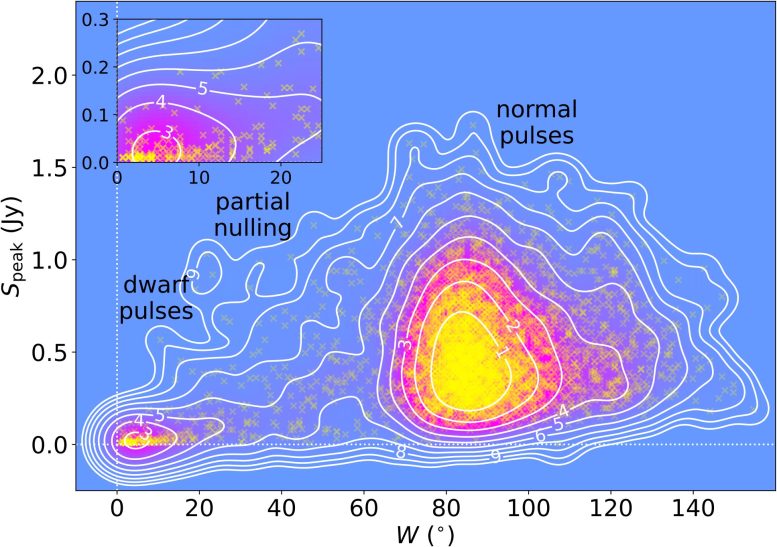
A team of astronomers discovered “dwarf pulses” from the pulsar PSR B2111+46 using the FAST telescope. Unlike regular pulsar emissions, these weak, narrow pulses represent a unique radiation state, often exhibiting a rare reversed spectrum. The study suggests that these pulses could help unveil the mysteries of pulsar radiation processes and the extreme plasma conditions within a pulsar’s magnetosphere.
Using the FAST telescope, researchers discovered unique “dwarf pulses” from pulsar PSR B2111+46, potentially unveiling unknown aspects of pulsar radiation and plasma conditions.
Using the Five-hundred-meter Aperture Spherical radio Telescope (FAST), a research team led by Prof. Jinlin Han from the National Astronomical Observatories of the Chinese Academy of Sciences (NAOC) has detected distinct “dwarf pulses” from a bright pulsar PSR B2111+46, and studied the radio emission in unprecedented details and probed the unknown physics in the magnetosphere.
This study was published today (August 17) in the journal Nature Astronomy.
Pulsar Emission and Pulse Nulling
Pulsars typically emit periodic radio signals. However, some older pulsars occasionally cease their emission for specific durations, a phenomenon known as “pulse nulling.” This might occur because particles cannot be produced in the magnetosphere due to unfavorable conditions or changes in the magnetic field structure and radiation region. Alternatively, the area for particle creation could become overwhelmed by plasma produced elsewhere.

Pulsar radio emission from thunderstorms and raindrops of particles in the magnetosphere of PSR B2111+46 detected by FAST. Credit: NAOC
The exact reason for the absence of pulsar radiation remains unknown. It’s challenging to determine the physical state of a pulsar’s magnetosphere when its radiation is suppressed.
Unprecedented Observations of PSR B2111+46
PSR B2111+46 is a relatively old pulsar, and scientists have long known that emission from this pulsar often nulls for periods of time. However, dozens of unusually weak, very narrow pulses — previously unobserved — were detected during ordinary nulling periods when it was serendipitously observed on August 24, August 26, and September 17, 2020, as part of the Galactic Plane Pulsar Snapshot survey, a key project of the FAST to hunt pulsars.
To verify this new kind of emission state, the researchers observed this pulsar for two hours again on March 8, 2022. “Finally, we picked out 175 such narrow, weak pulses,” said Dr. Xue Chen, the first author of the study. According to Dr. Chen, such pulses stand out from normal pulses in terms of pulse width and energy, and thus have been named “dwarf pulses.”

Dwarf pulses from pulsar B2111+46 exhibit distinct differences in pulse width and radiation energy compared to normal pulses, suggesting a new emission state different from ordinary pulsar radiation. Credit: NAOC
Nature of Dwarf Pulses
While standard individual pulses emit radiation through a “thunderstorm” of particles produced by extensive discharges in regularly formed gaps near the pulsar’s magnetic poles, dwarf pulses are produced by one or a few “raindrops” of particles generated by pair production in a fragile gap of this near-death pulsar.
These sporadic, weak, and narrow pulses constitute a new radiation state independent of normal pulses, and such pulses often exhibit a rare reversed spectrum, i.e., they have much stronger emission at higher radio frequencies, something that is very rarely detected in such a distinguished timescale from astronomical sources. “The properties of such dwarf pulses would be hard to be measured by other radio telescopes than FAST,” said Prof. Han, “and measurements of such a new population of dwarf pulses reveal that the magnetic field structure for the pulsar radiation remains unchanged even when the radiation is almost ceased.”
“In fact, a smaller number of dwarf pulses have also been detected from a few other pulsars,” said YAN Yi, co-first author of the study. “Detailed studies of such a dwarf pulse population could uncover some mysteries of unknown pulsar radiation processing and reveal the extreme plasma state in the pulsar magnetosphere.”
Reference: “Strong and weak pulsar radio emission due to thunderstorms and raindrops of particles in the magnetosphere” by X. Chen, Y. Yan, J. L. Han, C. Wang, P. F. Wang, W. C. Jing, K. J. Lee, B. Zhang, R. X. Xu, T. Wang, Z. L. Yang, W. Q. Su, N. N. Cai, W. Y. Wang, G. J. Qiao, J. Xu and D. J. Zhou, 17 August 2023, Nature Astronomy.
DOI: 10.1038/s41550-023-02056-z









Be the first to comment on "Pulsar Mysteries Unveiled: Unprecedented “Dwarf” Pulses Discovered With FAST Telescope"